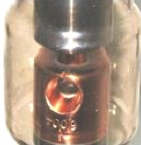Oil Immersed Low Power Tubes
Ref. E1



The hot-cathode line-focus tubes of different sizes, shapes and makes are oil-immersed, ranging in output from 50 kV and 5 mA for the smallest, to 90 kV and 20 mA for the bigger ones, and used in dental units or low power portable X-ray equipment. Since the introduction in 1920 of the CDX shock-proof oil-immersed dental X-ray unit by General Electric, and since the advent of the line focus tubes in the twenties, the basic structure of these tubes has not undergone any major changes.
Note the three types of anodes used in the different tubes :
- The bare anode, with the visible tungsten target.
- The hooded anode intended to limit the X-ray beam and limit the effect of “off-focal” radiation;
- The hooded anode with a beryllium window, adding some filtration of soft X-rays.
The introduction of the “hooded anode” is generally attributed to W.D.Coolidge, 1915. (E.R.N. Grigg – The Trail of the Invisible light – 1965 – pp 79 & 129). In fact, Victor Chabaud, of France, in the gas discharge tube bearing his name used a hooded anode, without giving it a name, as early as 1905 or 1906. An illustration of a hooded anode is equally seen in page 11 “Atlas TypischerRöntgenbilder, by Rudolf Grashey, J.F.Lehmann’s Verlag, 1912”.